
Burtons Farm, Barling
Article by Richard Kirton - 22nd April 2014
Based on an interview with Philip Splett, the current owner.
The unexpected scene almost took my breath away. Bathed in glorious sunshine, it truly looked idyllic. As I crossed the threshold into the immaculately-kept Burtons Farm complex it felt as if I had entered another small village within Barling.
I knew I was stepping back in time from the 21st century to the dark days of witchcraft, jailhouses, the hangman’s noose...but I discovered there is so much more to this historic hamlet with its butcher’s shop, red telephone box, row of terraces, a bungalow, lodge and farmhouse? But before delving back through the centuries to reveal its fascinating roots in the Middle Ages I begin by explaining more about Burton’s Farm as it is today.
Burtons Farm Complex Today
The aerial photograph was taken in 1995 and shows the position of all of the buildings which has not changed at all. Philip Splett and his wife Marian, together with their children Janet, Sandra, Sue and Julie relocated their London based business to Barling on 23rd September 1987 having purchased Burton’s Farm. The farm incorporated a small and not too well maintained farm shop and had bay windows and a distinctive red Telephone Box.
Philip converted the barn in the top left of the picture into a self-contained brick built bungalow with a high boundary wall and separate driveway. He eventually sold the bungalow as a detached and independent residential property.
In the early days he grew wheat and farmed hay and straw and soon started rearing pigs, chickens and lambs and revamped the shop into a family butchers shop. He had a smoking facility on the farm which in the early days 41/2 acres. Philip’s business today is aptly named ‘The Meat Emporium’ and he classes himself as a traditional butcher offering local specialties.
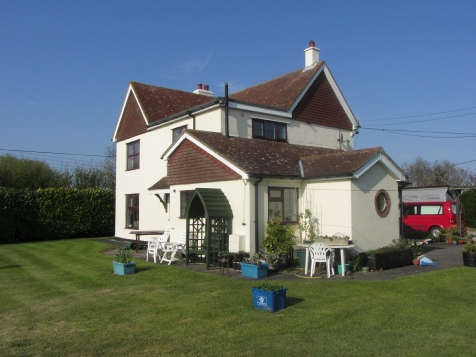 The Farmhouse today (April 2014) looks entirely different than it did in 1947 with its original red brick outer walls, now rendered and painted white.
The Farmhouse today (April 2014) looks entirely different than it did in 1947 with its original red brick outer walls, now rendered and painted white.
Philip Splett himself has lived at Burtons Farm since 1987 and various people have lived their before him including Robert Burton and his son John Burton and his son William Burton. Philip Benton and Thomas Rayner also lived there. and Caleb Rayner lived there in 1901 and another William Burton lived there in 1903.
A Merchant and Freemason by the name of Albert Lucking also lived there. In 1890, Southend was a rapidly growing town and there was only one Masonic Lodge in the borough; Priory Lodge number 1000.
By 1898, Albert Lucking had become a very distinguished Masonic brother and was privileged to have Albert Lucking Lodge number 2717 named after him. The lodge is one of the oldest lodges in Southend with a history of over 100 years and which spans all of the 20th century.
‘Left-Click’ on the photograph below to reveal a gallery of pictures relating to the refurbishment of Burton’s Farm.
History of Burtons Farm
T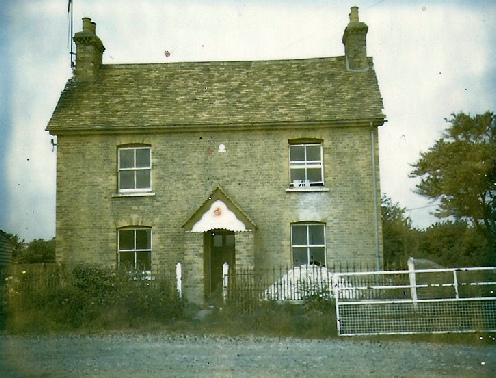 he following extract is from ‘The History of Rochford Hundred - The History of Barling’ by Philip Benton of Wakering Hall in 1867 [page 35].
he following extract is from ‘The History of Rochford Hundred - The History of Barling’ by Philip Benton of Wakering Hall in 1867 [page 35].
“Burtons (formerly called Ponds) is so named from Robert Burton, who came into possession in 1729, and died in 1750. His son John afterwards had it; and, in 1803, William Burton was owner. That portion lying in Barling was rated from 1719 to 1790 at £13: this seems almost incredible, but the rate books prove it for seventy-one years. These books are in the last stage of decay, having been taken from the parish chest into private keeping. This chest, when the author viewed, it, contained about six inches of mould and dust. The oldest book is in the best state of preservation, and it shows for five and thirty years, beginning at 1719, that the rating received very little alteration in any respect. Catherine Burton, a daughter of this house, married Barnaby Shorey, of Southchurch, in 1766. The Rev. James Salt bought the farm of the last of the Burtons, and intended, had he lived, to have chalked and improved it. Salt bequeathed it to Mrs. Maria Salt, of East Teignmouth, in Devonshire, the widow of his brother, John Salt, with reversion to his nephew, Thomas Salt, a surgeon of Dunmow. This last sold his interest to Samuel Benton, of North Shoebury House, who left it to his son, of the same name and place.
Upon Burtons farm resided, about 25 years ago, an eccentric tenant, who conceived the idea of clearing his field of cleaners by the following stratagem:—He caused the ends of a rope to be attached to two horses, that is, to the head of one, and the neck of the other: he and his servant then mounted, one riding in advance, so that the rope drew high and low, and galloping forward, attempted to surround the followers of Ceres: but perceiving the drift of the attack, most of them fled, and got upon a bank. The farmer and his man were saluted with the most opprobrious epithets. One of Eve's daughters refusing to quit the field, was entangled and tripped up.
A summons against the farmer was issued, and the result was a pecuniary fine, increased by the supposition of the complainant that she was about to become a mother, which afterwards proved groundless.—The farm is remembered at this time for its abominable culture, and the size and celebrity of its thistles, some of which were used for walking sticks.”
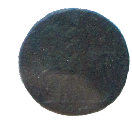 English Coin
English Coin
In September 2004 a very tarnished English coin was found in one of the farm fields. This particular coin was only minted in 1792. Apparently, in the late 18th century the Royal Mint did not make enough low value coins to satisfy the growing demand for small change. As a result, many towns and cities started producing their own token money. This halfpenny token was issued at Coventry in Warwickshire.
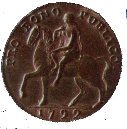 One side of the coin depicts the famous story of Lady Godiva with the legend PRO BONO PUBLICO. She supposedly rode naked through the streets to win a r
One side of the coin depicts the famous story of Lady Godiva with the legend PRO BONO PUBLICO. She supposedly rode naked through the streets to win a r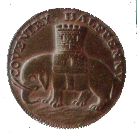 eduction in the city's taxes from her husband, Earl Leofric.
eduction in the city's taxes from her husband, Earl Leofric.
The reverse side of the coin shows a castle on the top of an elephant with the legend - COVENTRY HALFPENNY. Clearly the die cutter had never seen a real elephant.
Witches
‘Witches’ was a property adjacent to Burtons Farm to the east and it is believed that was where women suspected of being a witch were subjected to the ducking stool test. There were several ponds which spanned Burtons Farm and the Witches but they are not here today.
Ducking was seen as a fool proof way to establish whether a suspect was a witch. The ducking stools were first used for this purpose but ducking was later inflicted without the chair. In this instance the victim's right thumb was bound to left toe. A rope was attached to her waist and the 'witch' was thrown into a river or deep pond. If the 'witch' floated it was deemed that she was in league with the devil, rejecting the 'baptismal water'. If the 'witch' drowned she was deemed innocent.
The Meat Emporium
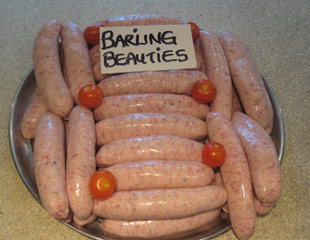 The award winning Barling Beauties are
The award winning Barling Beauties are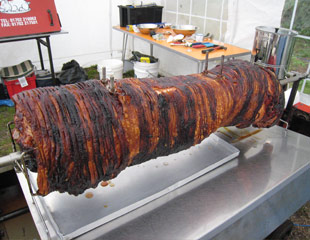 Philip’s Trademarked low fat Sausage, often imitated but never beaten. They are 87% pork meat with the recipe passed down throughout the generations. Also, Philip is renowned locally for his high quality ‘Hog roasts’ and new for 2013 he is offering ‘Lamb roasts’. Both complement that ‘special gathering’.
Philip’s Trademarked low fat Sausage, often imitated but never beaten. They are 87% pork meat with the recipe passed down throughout the generations. Also, Philip is renowned locally for his high quality ‘Hog roasts’ and new for 2013 he is offering ‘Lamb roasts’. Both complement that ‘special gathering’.
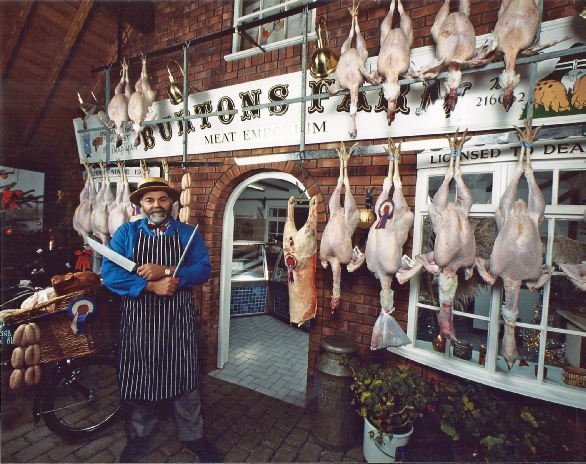



© 2015 - Richard Kirton - All Rights Reserved | Privacy Policy | Terms of Use | Site Map

